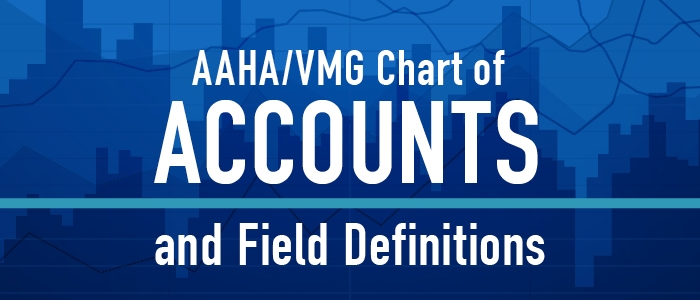Improve Your Practice Finances with the AAHA/VMG Chart of Accounts and Field Definitions
 AAHA’s trusted financial resource, AAHA/VMG Chart of Accounts, just got even better: A new online version is now available free to the veterinary profession.
AAHA’s trusted financial resource, AAHA/VMG Chart of Accounts, just got even better: A new online version is now available free to the veterinary profession.
AAHA’s Chart of Accounts set the standard for financial accounting when it was introduced 20 years ago. Over the years it was revised to reflect the growing complexity of veterinary practice accounting. Last year, AAHA joined forces with Veterinary Management Groups (VMG) and several other key veterinary organizations, including the AVMA, Veterinary Hospital Managers Association, and VetPartners, to revise and expand the system, and renamed it the AAHA/VMG Chart of Accounts and Field Definitions.
This move coincided with an effort by the American Veterinary Medical Association (AVMA), which tasked its Veterinary Economics Strategy Committee (VESC) with facilitating the collaboration necessary to improve business knowledge, acumen, benchmarking, and financial success across the profession.
As a result, the AVMA-VESC initiated the Economic Advisory Research Council. Rather than build a new standardized chart of accounts from scratch, the council adopted the AAHA/VMG Chart of Accounts.
Standardized codes enable the profession to develop better measures of veterinary practice financials (benchmarks) and allow practitioners to organize their finances in line with generally accepted accounting principles. They also provide better, more reliable data about how veterinary practices are doing from an economic standpoint and enable industry leaders to develop initiatives designed to improve the overall financial health of the profession.
The AAHA/VMG Chart of Accounts is now the standard for classifying revenue, expense, and balance sheet accounts in small animal veterinary practice. Additionally, AAHA, VMG, AVMA, VHMA and Vet Partners recommend that all accounting firms working with veterinary practices adopt the standardized codes.
Is your practice still trying to adapt to generic accounting codes? Use the chart of accounts recommended by industry experts for every revenue center in your practice. Access the AAHA/VMG Chart of Accounts at aaha.org/coa.
Why did we decide to provide the AAHA/VMG Chart of Accounts at no cost?
From the beginning, the organizations involved in developing this chart of accounts (COA)—AAHA, Veterinary Management Groups, American Veterinary Medical Association, Veterinary Hospital Managers Association, and VetPartners—had a goal of developing a COA that would become the standard for classifying revenue, expense, and balance sheet accounts throughout small animal veterinary practice. In order to minimize barriers to utilization of this new standard, it was important to provide the COA at no cost.
What is the importance of a standardized COA to the veterinary profession?
Standardized veterinary accounting codes aid in the development of more accurate measures of practice financial health for every veterinary practice and for the veterinary profession. This economic data enables practices to measure their individual success as well as enabling industry leaders to develop and measure the impacts of initiatives designed to improve the overall financial health of the veterinary profession.
Why should you use the AAHA/VMG COA?
Until now, financial metrics within veterinary practices have often been underutilized because of an inability to make valid comparisons with industry averages. This has been due to uncertainty about whether various revenue and expense items were categorized the same way.
The new AAHA/VMG Chart of Accounts and Field Definitions creates a standardized, well-organized financial picture for practitioners and their financial advisors. Adopting the new COA format will allow for assessment and apples-to-apples comparison of practice metrics, such as productivity, costs, and profitability against averages, for veterinary practices throughout the profession.This provides a true measure of financial success for a practice.
How should a practice implement the AAHA/VMG Chart of Accounts and Field Definitions?
These are the steps to realign practice management system and financial accounting software to begin the implementation of the new standardized COA:
1. Align the revenue categories in your practice management software using the standardized revenue definitions available in the COA (aaha.org/coa).
2. Align the inventory product categories in your practice management software using the standardized direct cost definitions available in the COA.
3. Convert your practice’s current COA in your financial accounting software to the AAHA/VMG Chart of Accounts using one of the listed resources.
4. Contact vendors to see if they have updated their invoicing to align with the AAHA/VMG Chart of Accounts to streamline the classification of future invoices.
5. There are professional accounting businesses which can assist practices with this transition.
AAHA and VMG are working diligently to continue providing resources, such as practice management system user guides, to assist with accomplishing each of the steps above. Revenue and inventory reports from the practice management systems can be used to help translate the financial data on the practice financial reports into more meaningful breakdowns that will enable the practice to identify opportunities for improvement to the financial health of the practice.



